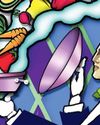Examining the possible links between blood type and health.

Probably the only time you think about blood type, if ever, is when there is a blood drive and you’re planning to donate, or if you (or someone close to you) are in the unfortunate situation of requiring a blood transfusion. You may know, then, whether you are type A, B, AB, or O, collectively referred to as the ABO blood group, which is believed to have evolved from a primate ancestor millions of years ago.
Your blood type, inherited from your parents, refers to the antigens (molecules that can cause an immune response) found on the surface of your red blood cells. The ABO blood group results from one gene that has three variations: A, B, and O. Blood type A has A antigens, type B has B antigens, AB (the least common type) has both, and O (most common) has neither.
Before blood typing was discovered in the early 1900s, a blood transfusion could, and often did have fatal consequences. That’s because the body’s immune system normally identifies and attacks foreign antigens, whether they are from bacteria that have entered the body, a transplanted organ, or anything else. In the case of blood type, if a person with type A receives type B blood, for example, antibodies (proteins produced by certain immune cells to counteract foreign antigens) will respond by attacking the B antigens, leading to the destruction of red blood cells, which can result in death. Note that there are actually several other types of blood-typing systems besides ABO that are addressed when blood is ‘typed and cross-matched’ prior to a blood transfusion.
From Heart Disease To Malaria
This story is from the OCT 2018 edition of Health & Nutrition.
Start your 7-day Magzter GOLD free trial to access thousands of curated premium stories, and 9,000+ magazines and newspapers.
Already a subscriber ? Sign In
This story is from the OCT 2018 edition of Health & Nutrition.
Start your 7-day Magzter GOLD free trial to access thousands of curated premium stories, and 9,000+ magazines and newspapers.
Already a subscriber? Sign In

Internet Can Boost The Health Of The Elderly!
Here are five ways the Internet can help boost your health.

Hair Today, Gone Tomorrow
Going through major hairfall? These could be the reasons…

What's Your Sleep IQ?
Answer these questions so you can identify poor sleep patterns or symptoms and seek treatment.

Digital Mindfulness To Curb The Modern-Day Screen Addiction
…is the need of the hour, to curb the modern-day vice of screen addiction.

6 Ways …to Stay Fit And Healthy In The Cold.
6 ways …to stay fit and healthy in the cold.

A Diet For Your Skin
Eat according to your skin type. We show you how…

What To Eat And What Not Before And After A Workout
Your guide to what to eat and what not before and after a workout.

5 Lifestyle Changes To Adopt This Party Season
A peek at how binge smart, in this season of parties.

BRA-VO
!In this month of creating awareness for breast cancer, we show you how to choose the right bra to maintain goodbreast health…

Lose Weight
…Without getting hungry. Here’s how…